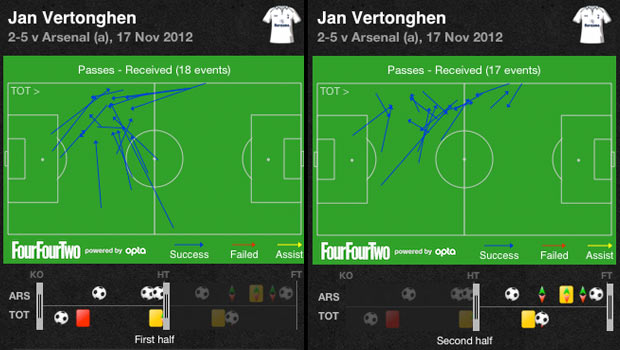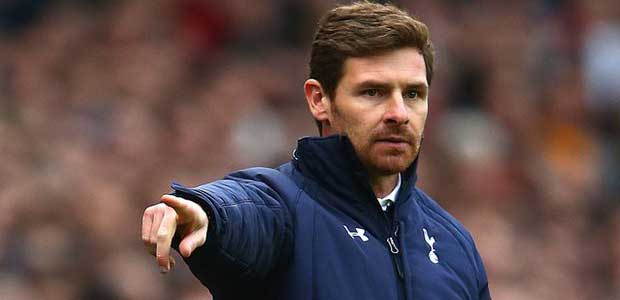Teams using two strikers are starting to come back in to fashion in the Premier League this season. Man Utd, Liverpool and Man City are among teams that are flirting with the twin-pronged attack, as are the likes of Norwich and also our most recent visitors, Newcastle.
The Magpies’ Loic Remy and Shola Ameobi not only gave us a headache by running in-behind, but also the two of them condensed the space for our centre backs by pressing in from wide starting positions. This meant that Michael Dawson and Vlad Chiriches (then Younes Kaboul) couldn’t move the ball out as easily to our full backs. Something that they are accustomed to doing against sides playing with a lone striker.

By hemming our centre backs in, Remy and Ameobi forced them to either pass the ball forward in to central areas or to split much wider apart than they wanted to.
The ball then had to be sent over a greater distance between our two centre backs, slowing down our ability to move quickly forward.

Playing two strikers also meant that both of our centre backs were occupied when Newcastle had the ball, especially if our full backs had gone forward.
Most teams like to have a man over at the back to act as cover. This is fine against a lone striker as we’ll have 2v1, but against teams playing with two front men, adding a third centre back can offer this security.
Our next two Premier League games are also against teams that play two strikers, Man City and Man Utd, whilst Liverpool also loom on the horizon.
So should we consider playing with three at the back against teams that are favouring two front men?
The benefits of a back three against 4-4-2
That shift to a back three creates a number of benefits against teams playing 4-4-2.
First of all it would give us a stronger defensive presence in the centre of the park. Immediately against teams playing with two strikers you have an additional defender to act as cover to have 3v2.
On Newcastle’s goal on Sunday, if Loic Remy had been playing as a lone striker then Michael Dawson could have come over as cover to help Vlad Chiriches. As it was, with Kyle Walker caught forward from the quick turnover in possession, he had to respect the run of Shola Ameobi.

What’s more, Michael Dawson is strong in the air, but slow over the ground. He may be better deployed in a defensive three where he is sweeping behind faster centre backs against a twin-pronged attack.
Secondly, It would also permit Jan Vertonghen, Vlad Chiriches and Younes Kaboul to make forward bursts to create overloads further forward.
Jan Vertonghen is not averse to playing at full back where he can bomb on, as he did in scoring at Old Trafford. But he also has done the same from centre back, highlighted in his strikes last season in Swansea 1 Spurs 2 and Liverpool 3 Spurs 2.

As we know, Younes Kaboul also likes to move forward in to the attack, as does recent arrival Vlad Chiriches. The Romanian developed a reputation for doing this in his time at Steaua Bucharest, where his surges out from defence became legendary and he set up and scored a number of goals.

In Arsenal 5 Spurs 2 at the Emirates last season, Andre Vilas-Boas went with a back three in the second half after Emmanuel Adebayor’s sending off. Whilst only playing with ten men, how much more attacking Jan Vertonghen could be was clearly evident after the switch.

Thirdly, a back three also provides more cover for the full backs. Their ability to get forward and receive passes played through the defence is key to our system this season. A back three – as highlighted on Remy’s goal – would afford more protection against two centre forwards if the wingbacks were caught up field.
Fourth, it also permits us to have the choice of two centre forwards, a lone striker and a number ten, or to play with wide forwards.
A back three can be deployed in a 3-5-2 formation which would allow us to play a partner with Roberto Soldado in a twin pronged attack of our own.
It could also be used with Christian Eriksen or Lewis Holtby just off of the Spaniard as a lone striker. If we wanted to be more aggressive then a direct dribbling number ten, such as how Erik Lamela played for River Plate, could also be used behind Soldado.
If we were to stick with our current game plan of utilising wide forwards, then we could play a 3-4-3 formation against teams using two strikers. This keeps the security of 3v2 at the back, whilst maintaining the additional attacking presence of a central number nine with two wide forwards.
Drawbacks of a back three against 4-4-2
The main drawback is that by adding an additional player to our defence, we are going to have to give something up elsewhere. This is either in the wide positions or in central midfield.
A switch to a 3-5-2 would mean having to either dispense with our wide forwards or to use one or both of them aggressively in the wingback positions.
Alternatively, a move to a 3-4-3 would mean that we’d have to dispense with one of our current trio of central midfielders.
Of course Sandro or Etienne Capoue could play in a role to drop in to the defence to create a three when possession is lost and then move up in to midfield when it is won back, but this does carry the risk of being caught 2v2 due to a quick transition.
Could Spurs use a back three against 4-4-2?
There were a number of warning signs against Newcastle that there may be trouble on the horizon against better opponents. Man City, Man Utd and Liverpool whom we face in the span of our next five Premier League games, all deploy two strikers that can cause us greater problems than Newcastle.
Opponents playing two strikers up top allow them to hem in our centre backs, whilst it also gives them two players to then try and get in-behind our high defensive line. Sergio Aguero tried this repeatedly last season for Man City and i wouldn’t bet against him attempting the same this term.
With the number of excellent centre backs we have at our disposal, moving to a back three is an option for Andre Villas-Boas against sides playing 4-4-2.
If we did switch, then it would either require sacrificing some of our wide players, which is often where we gain an advantage, or a central midfielder. It is for this reason that I could only see us playing this system when we are up against two strikers to not leave us outnumbered in midfield.
Although not a perfect system, three men at the back is an option for Spurs this season against teams playing a 4-4-2.

Against City, I fully expect Nasri to be coming in from their left to create overloads in midfield. With that as a base, it might be dangerous for Spurs as they can launch through ball from there behind Spurs’ highline for the speedy and dangerous Aguero. So I think keeping that central area in control is important.
3-5-2/3-5-1-1 is an option as that leaves 3 in the center and 3v2 at the back, the caveat being that Spurs might be overloaded on the left versus Navas and the overlapping Zabaleta. That can be rectified with the No.10 (playing off a lone striker) and dropping back to midfield to help control there, while one of the deeper midfielders tracking the run of Zabeleta providing dangerous crosses for the tall Negredo, not ideal but may work? I could also see Townsend (as right wing back) having a field day having quick transitions, going up against a single fullback as Nasri isn’t in position/or poor at tracking back.
4-3-3 is another option, where the pivot player can drop back to form a 3-4-3 at times, but Spurs might be caught between needing an extra player in midfield and an extra player in defense just like you said. Though we do have one of the best sweeper keeper in case they get behind the defense.
Good arguments for both but I’d just go for 4-3-3, as that’s the base formation that AVB is using in the long-term and the squad is more familiar with that. I rather they be familiar with a formation as a base for perfecting and learning their roles within that, rather than potentially creating further instabilities while already having so many things yet to learn, so many new players trying needing time to learn a single formation already. They won’t have too much time to learn it versus City after the international break. I also don’t think Soldado is mobile enough to operate as a sole forward in a 3-5-1-1 leaving him really isolated with not much supply from the wings given that there will be no overlapping fullbacks to provide cut backs/crosses, nor in a 3-5-2 partnering with Defoe whom I don’t think complement with Soldado.
Certainly an intelligent winger coming inside from the left is our worst fear, as that’s exactly the type of player that Walker struggles against.
Personally I think moving to a back three so suddenly would be too much of a shock to the system for the team. We’ve really only looked decent for that second 45 minutes against Newcastle, such is the time it’s taking them to bed in. If Sandro can stay fit, he’s almost acting as effectively as a third defender screening in front of the back four (though that is often a back to with our full backs so far pushed up).
With Lloris back in goal, I’d be happy with a couple of draws against those sides – and we certainly do look solid at the moment. Of course, the risk of being solid but not able to score is that it only takes one goal for us to really be up against it.
Good point about Walker Chris – Nasri scored City’s opener in our 3-1 victory at the Lane after drifting inside and losing Kyle to convert Milner’s cutback.
Given that a number of players have been quoted as saying how much AVB works on different set ups, situations and tactics, it wouldn’t surprise me if he has worked on a back three in training. AVB likes his teams to be fully prepared for what they can expect against a specific opponent, so with three of our next five Premier League matches coming up against teams with tandem strikers, this could be something that’s been practised.
Of course if they haven’t worked in it, then yes it would be too much of a shock to the system. I think players should operate in a set up that they’re comfortable with, but if it has been worked on, then i wouldn’t be surprised to see it rolled out.
Great post Boon! I too expect Nasri to move inside in to the cen tre to create overloads, against Sunderland at the weekend he spent a huge amout of time in the middle and even on the right from his starting position on the left – more on this coming up and the effects of it in the tactics preview next Friday.
We will need something additional in the centre though, whether it is Sandro or Capoue coming in or an extra centre back. Moussa Dembele has been getting the nod as the deepest midfielder, expecially against supposed weaker teams recently, in order to get more attacking thrust in to the midfield three. I can’t see him playing here against either City, Utd or Liverpool though, especially if they have two centre forwards as control of this area will be crucial.